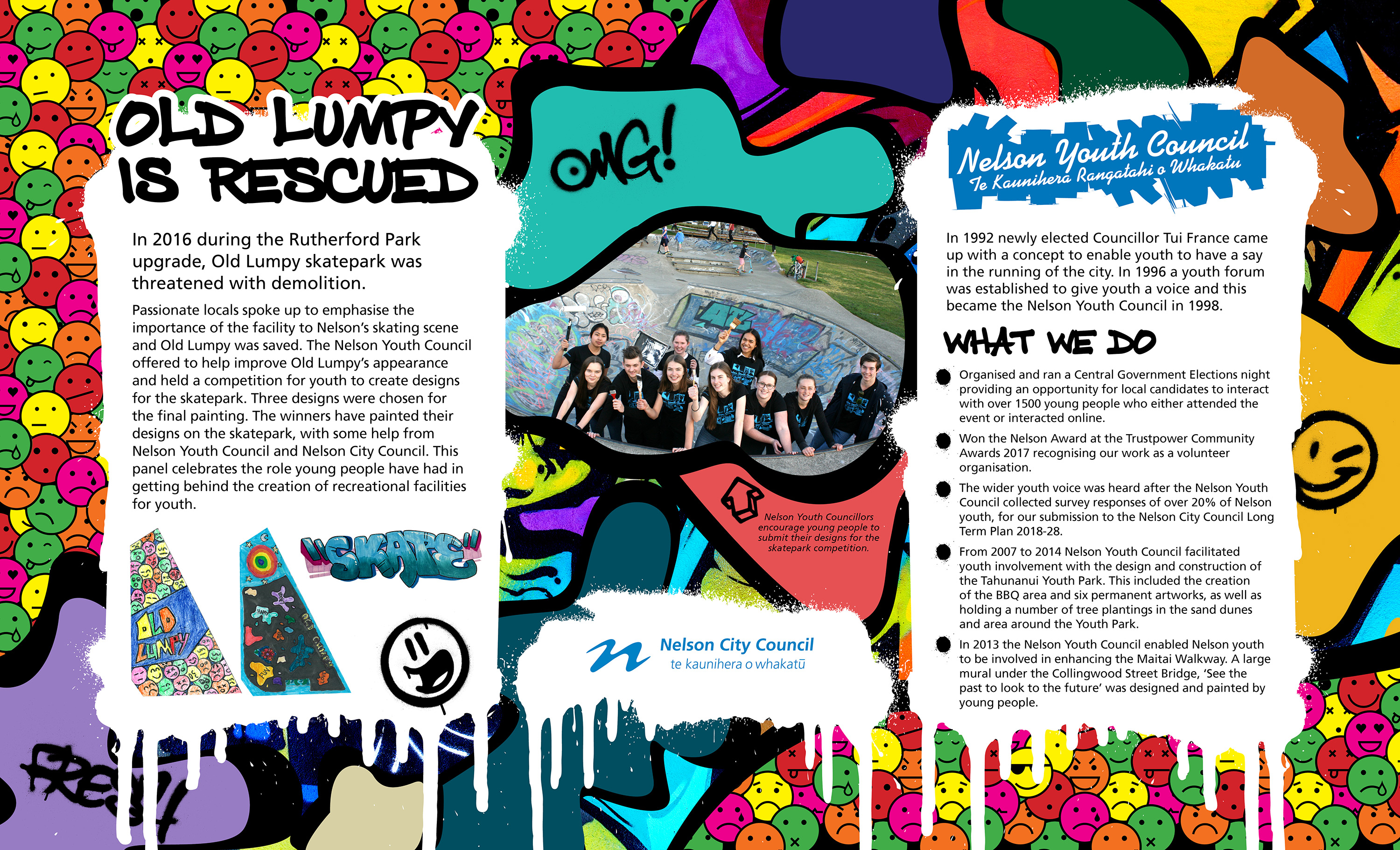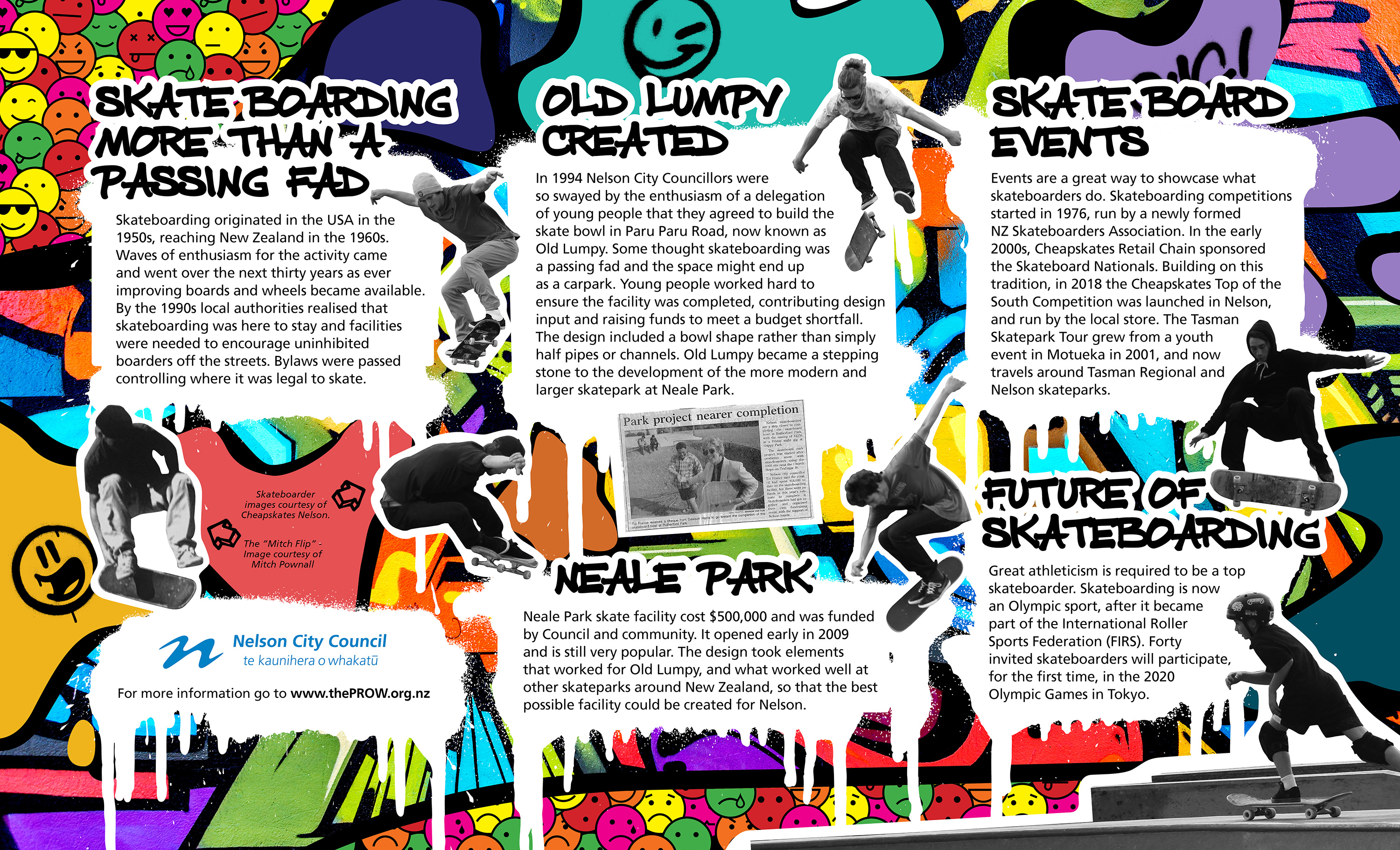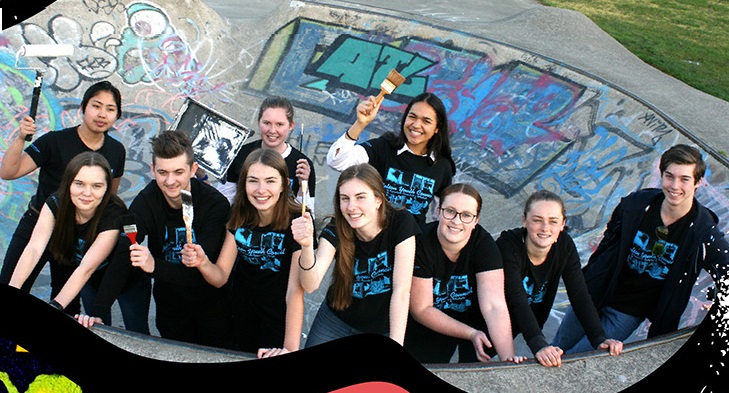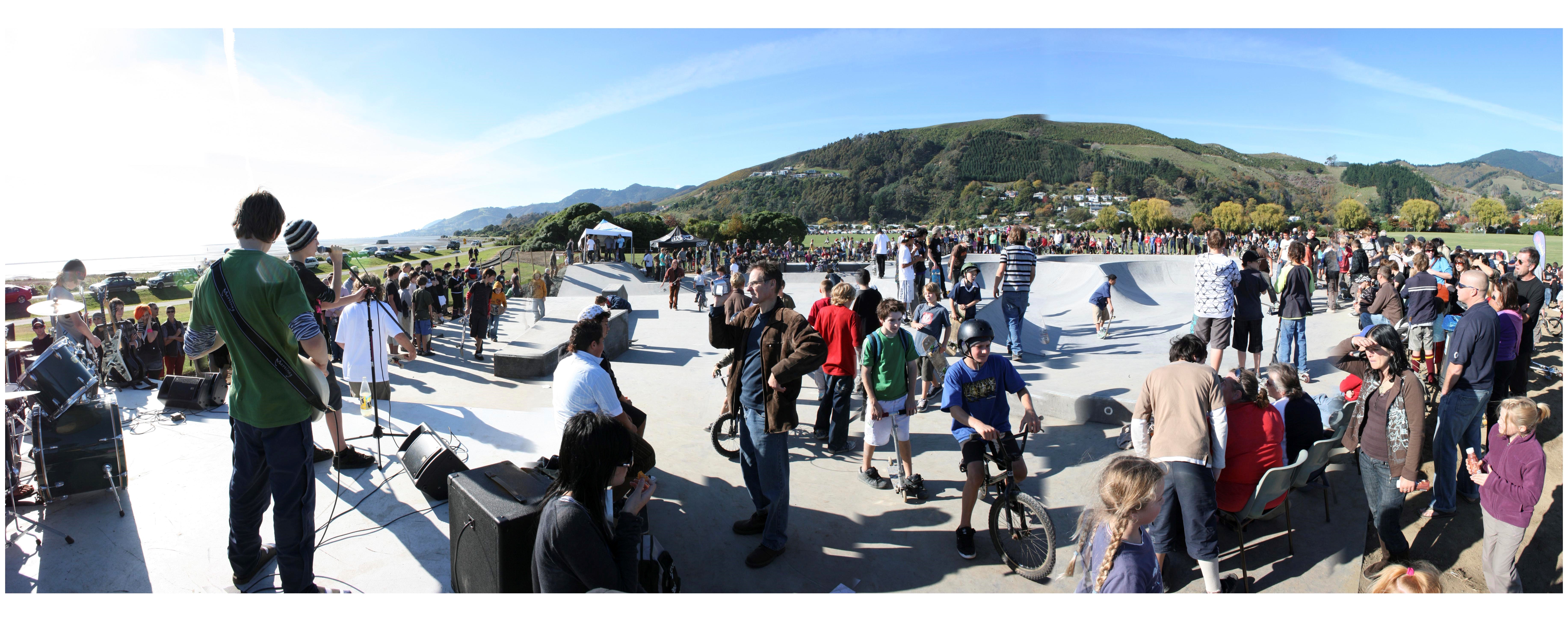Skateboarding in Nelson
Skate Boarding comes to New Zealand When Surfers made boards with wheels so they could ‘sidewalk surf’ in the USA in the 1950s, a new sport called skate boarding was born.
Skate Boarding comes to New Zealand
When Surfers made boards with wheels so they could ‘sidewalk surf’ in the USA in the 1950s, a new sport called skate boarding was born.1 Enthusiasts created their own boards adding roller skate wheels to planks, but by the time skateboarding was established in New Zealand commercially made boards were available.
The sport reached New Zealand in the 1960s. Waves of enthusiasm for skateboarding came and went over the next thirty years as ever improving boards and wheels became available. The urethane wheels in the 1970s were a landmark and technical improvements just keep making boards faster, more manoeuvrable. Today the latest skateboards still have urethane wheels but manufacturers are more eco-conscious about using better glues, looking at the composition of urethane. The board is now usually made out of renewable wood and bamboo or mixtures, and top end boards are made of carbon fibre for a lifetime of use, as they cannot be snapped.2
Skateboarding competitions started in 1976, run by the newly formed New Zealand Skateboarders Association. The Association was created by a group of New Zealand skateboard manufacturers, surf shop owners and skateboarders, that among other things, started to run skateboarding competitions.
Early skateboarding
Early boarders generally used local streets and parks, and carpark buildings. Some skaters built ramps at their homes so they could do vertical skating.
Skateboarders on the streets were unpopular with the public as they often travelled at speed on roads and footpaths, or skated down steps, along park benches or parking buildings. In the 1970s speeds of 50mph (80.46km/h) on a skateboard had been recorded in America and noted in the Guinness Book of Records. Today the current downhill speed record is 80mph (143kmph). The desire to emulate this must have been powerful for local boarders, much to the alarm of those they encountered.
Public complaints about damage to sidewalks, benches and steps, and the speed of the boards on the pavement led to the creation of bylaws to keep boarders out of various places such as shopping areas.
Skateboards are legally classed as vehicles and can be ridden on the road, but skaters do not have to wear a helmet. Skateboarders on footpaths are required to ride carefully and considerately and give way to pedestrians and mobility scooters. By the 1990s local authorities realised that skateboarding was here to stay and that purpose-built facilities were needed to encourage uninhibited boarders off the streets.
Skateboarding in Nelson
Nelson City Council created specific bylaws.3 relating to where skateboarding can occur in Nelson. The Central Business District in Nelson was not a permitted area. In the 1990s boarders often met around the 1903 Square in Trafalgar Street, at the bottom of Church Steps.4 These soft granite steps, which are a heritage site, were easily damaged by skate boards. Council knew they needed to tackle the skate boarding craze.
In 1994 Nelson City Councillors were impressed by the enthusiasm of a delegation of young people, who were pressing for a skateboard facility. The Council was keen to have the boarders off the streets and they agreed to build the skate bowl in Paru Paru Road, now known as Old Lumpy. Although some Councillors thought skateboarding was a passing fad, they considered the project had merit, even if the space might eventually end up as a carpark. $24,000 was allocated from the Parks budget for the creation of the facility.5
In the early 1990s, few Councils in New Zealand had invested in facilities for skateboarders. Carpark buildings in large cities provided excitement after hours.
The creation of Old Lumpy
Nelson City Council Parks designer Peter Coubrough rose to the challenge of creating a workable facility that met the expectations of the boarders and fitted the budget available. Youth were so committed to the project that when it looked like a shortfall in funding might end the project, they fundraised the balance required. They held a band concert at Guppy Park and raised $1250, an impressive contribution.
The design was driven by a committee. It included a bowl shape rather than simply half pipes or channels. Coubrough worked hard to fit in as many ideas as possible that would work in the limited space. The most technically challenging to build, but most exciting for the boarders, was the inclusion of a skate bowl into the structure. To save money on the skate park, workers who were employed by Council under the Government’s Project Employment Schemes were used. They were moved from another community project (the Japanese Garden construction) to construct the Skate Park. The site available for the skate park was over an old Council works yard so the land was quite well compacted, which saved money on piles.6
Youth Council and Old Lumpy
Old Lumpy remained popular even after the development of the more modern and larger skate board park at Neale Park in 2009. In 2016 during the Rutherford Park upgrade, Old Lumpy skatepark was threatened with demolition. Passionate locals spoke up to emphasise the importance of the facility to Nelson’s skating scene and Old Lumpy was saved. The Nelson Youth Council offered to help improve Old Lumpy’s appearance. They held a competition for youth to create designs for the skatepark. Three winning designs were chosen for the final painting. The winners painted their designs on the skatepark, with some help from Nelson Youth Council volunteers and Nelson City Council. A history panel was created to celebrate the role young people have had in getting behind the creation of recreational facilities for youth.
Old Lumpy had a role to play in the way later skate parks have developed, being one of the early “skate bowls “ in New Zealand. Other centres such Wellington, checked out what worked well in Nelson, when they developed their facilities.7
Skate boarding increases in popularity
In the early 2000s, the Cheapskates Retail Chain sponsored the Skateboard Nationals.8
A popular event in the Nelson Tasman region developed from an event in Motueka in 2001. In January 2002 the Tasman Youth Council ran an event based on this, that they called “Sunnyside UP”. This was funded by Tasman District Council, with Cheapskates being the key sponsor of a skateboard competition which was an important part of the event. The first event had performances by Yellow 7, DJ Ziggidy + Lyrical Technician, Minuit and Trinity Roots. Sunnyside Up ran with a Cheapskates competition as a part of it, until 2006.
In 2007 Tasman District Council decided to allocate their funding to a regional Skatepark tour across the district with performances. By this stage skateparks facilities, of varying sizes, could be found across the Tasman region in Motueka, Richmond, Brightwater, Mapua, Takaka, Tapawera, and Murchison. Cheapskates continued to provide sponsorship. The first of these Skatepark Tours was run in January/February 2007.9
By 2009 the large Neale Park skatepark facility in Nelson was completed and is now included in the tour.
Building on this tradition, in 2018, the Cheapskates Top of the South Competition was launched in Nelson, and was run by the local Cheapskate store.
Creation of Neale Park Skate Park
As skateboarding became a popular sport with all ages, Youth groups including Nelson Youth Council lobbied for increased and improved space for skateboarding in Nelson. As part of the wider development of Neale Park, which contains recreation facilities for a wide range of sports, funding of $500,000 was specifically allocated towards a high spec skate facility. The structure needed to be shoe-horned in, to fit around all the other sports to be included in Neale Park.
Funding was a joint effort by Council and community. As the structure was large and weighty, and Neale Park was the site of an old landfill, engineering was always going to be a big factor in the cost. As with Old Lumpy, the design was by committee, with plenty of ideas from skateboarders to try and incorporate into the design. The design used elements that worked for Old Lumpy, and what worked well at other skateparks around New Zealand, so that the best possible facility was created for Nelson.
Neale Park Skatepark opened early in 2009 and remains very popular.
Future of Skateboarding
From 2008 Wellington has hosted Bowl-a-rama, an international professional skateboarding competition. This is now known as Bowlzilla. The highest placing New Zealander in this annual international competition takes the national title. Results from the competition contribute to world cup skateboarding rankings. The finals of the competition is held at Waitangi Park, Wellington.
Local boy, 10 year old Alex Moreu learnt to skateboard with his father and brothers in Nelson. His talent was observed in the Skate Park Tour and Nelson Cheapskates sponsored him when he was invited to compete at Bowlzilla in Wellington and also at Bowzilla Gold Coast where he showed off his potential to become a champion.
The emergence of such talent has stimulated a local Skate committee to be formed to support the development of a skate facility at Tahunanui Reserve in the space where an old ramp used to be.
Skate Boarding in Olympics
It is now recognised that great athleticism is required to be a top skateboarder. Skateboarding is now included as an Olympic sport, after it became part of the International Roller Sports Federation (FIRS). Forty invited skateboarders will participate, for the first time, in the 2020 Olympic Games in Tokyo.
2018
Story by: Debbie Daniell-Smith
Sources
- Pollock, K. 'Roller skating and skateboarding - Skateboarding', Te Ara - the Encyclopedia of New Zealand (accessed 24 September 2018).
https://teara.govt.nz/en/roller-skating-and-skateboarding/page-2 - Pers. comm. Cam Bary owner and Tom Eggers of Cheapskates (Aug 2018)
- O'Regan, S. (1997, June 7) Skate strife. Nelson Mail , p11.
- Nelson City Council Minutes
- Nelson City Council Minutes
- Pers comm Peter Coubrough, Nelson City Council (Aug 2018)
- Pers comm Peter Coubrough and Andrew Petherham, Nelson City Council (Aug 2018)
- Pollock
- Pers. comm. Brent Raru and Mike Tasman Jones, Tasman District Council (Aug 2018)
Further Sources
Newspapers
- Anderson, C. (2018, September 12) Memories of skateboarding glory. Nelson Weekly
http://nelsonweekly.co.nz/2018/09/memories-of-skateboarding-glory/ - Rollo, P (2018, March 10) New Zealand's top skateboarders weigh in on Olympic Games debate, Retrieved from Stuff:
https://www.stuff.co.nz/sport/olympics/102132842/new-zealands-top-skateboarders-weigh-in-on-olympic-games-debate -
Nelsonians get on board with new park (2009, January 31) Nelson Mail, Retrieved from Stuff:
http://www.stuff.co.nz/nelson-mail/news/450147/Nelsonians-get-on-board-with-new-park
Websites
- Skate-parks, Retrieved from Nelson City Council, Retrieved 27 September, 2018:
http://www.nelson.govt.nz/recreation/recreation/parks-and-reserves/skate-parks/



